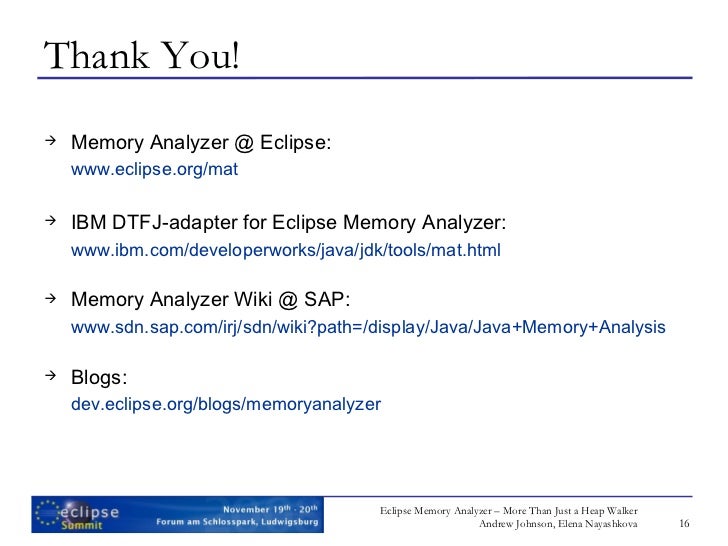Eclipse Memory Analyzer
Details Group Tabs
How can I perform memory analysis of this heap dump within IntellIJ IDEA? I know that there are tools for Eclipse and Netbeans but I would rather use IDEA if possible. The basic results of the analysis would tell me the number of instances of each object in memory, per-class, to allow me to be able to start debugging memory leaks. Jun 27, 2018 Release Date: Wednesday, June 27, 2018. Deliverables: Check and fix Memory Analyzer running under Java 9 or Java 10. Check and fix the loading and indexing of dumps from Java 9 and Java 10. Fix queries including collections and Equinox bundles for new releases of Java and Eclipse. Fix some reproducible bugs reported by end users. I'm trying to analyse a memory leak in one of my Java programs (which uses Swing), so I downloaded the Eclipse MAT. What I've done so far: Ran the program from within Eclipse by clicking the Run button. Switched to the Memory Analysis perspective; Selected 'Acquire Heap Dump from a locally running VM' while the program is running. The Eclipse Memory Analyser Tooling (MAT) is a set of plug-ins for the Eclipse IDE which provides tools to analyze heap dumps from Java application and to identify memory problems in the application. This helps the developer to find memory leaks and high memory consumption issues. Individual Contribution Activity: Commits on this project by individuals over the last three months. Andrew Johnson Kevin Grigorenko Jason Koch 94.4%. Kevin Grigorenko.
The Eclipse Memory Analyzer is a fast and feature-rich Java heap analyzer that helps you find memory leaks and reduce memory consumption. Use the Memory Analyzer to analyze productive heap dumps with hundreds of millions of objects, quickly calculate the retained sizes of objects, see who is preventing the Garbage Collector from collecting objects, run a report to automatically extract leak suspects.
- mat,
- memory,
- heap,
- analyzer,
- leaks,


Eclipse Memory Analyzer Download
Eclipse Memory Analyzer Heap
| Date | Ranking | Installs | Clickthroughs |
|---|---|---|---|
| August 2021 | 39/719 | 523 (0.44%) | 3 |
| July 2021 | 40/826 | 1763 (0.44%) | 23 |
| June 2021 | 41/842 | 1830 (0.41%) | 16 |
| May 2021 | 44/866 | 1684 (0.37%) | 25 |
| April 2021 | 44/914 | 1893 (0.4%) | 17 |
| March 2021 | 44/918 | 2032 (0.39%) | 14 |
| February 2021 | 44/911 | 1567 (0.37%) | 19 |
| January 2021 | 45/930 | 1674 (0.37%) | 27 |
| December 2020 | 42/919 | 1870 (0.44%) | 19 |
| November 2020 | 44/925 | 1925 (0.42%) | 31 |
| October 2020 | 42/927 | 2053 (0.44%) | 19 |
| September 2020 | 39/894 | 2238 (0.5%) | 15 |

Unsuccessful Installs in the last 7 Days: 1
| Count | Error Message |
|---|---|
| 1 | Cannot complete the install because one or more required items could not be found.... |
How To Use Eclipse Memory Analyzer
Download last 500 errors (CSV)OverviewGet an overview of the heap dump: Size and total number of objects at the top, then a pie chart with the biggest objects and links to continue the analysis. |
Eclipse Memory Analyzer Java Heap Space Error
HistogramThe histogram lists the objects grouped by their class. The Memory Analyzer can approximate the retained size very quickly. This is a good indicator where to continue with the analysis. |
Eclipse Memory Analyzer
Dominator TreeThe Dominator Tree lists the biggest objects. One could call it a 'Keep-Alive Tree' because the next level shows those objects which are immediately prevented from being garbage collected. Right-click to drill down: view the outgoing and incoming reference or view the path to the GC roots to see the reference chain which keeps the objects alive. |
Path to GC RootsThe path to the GC Roots shows the reference chain which prevents that the object is garbage collected. Objects decorated with a yellow dot are Garbage Collection (GC) Roots, i.e. objects which are assumed to be alive. Usually GC Roots are objects that are currently on the call stack of a thread or system classes. |
Dominator Tree Grouped by Class LoaderAny decent architectures loads components by different class loaders. Many views of the Memory Analyzer allow you to group the objects by class loader and, hence, easily analyze memory by component. To map the class loader to a meaningful component name (for example the plug-in id), one can plug-in name resolver. |